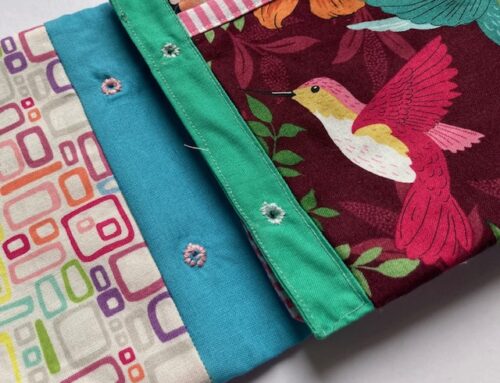Embroidery and patchwork quilting are beautiful ways to capture moments, memories, and even the passage of time. For the past few years I have been watching others create wonderful year long weather forecasts with their crafts. With a few failed attempts this year, now 5 months in I can officially say that I am tracking the temperature. Tracking temperatures through embroidery or patchwork is not only a unique creative endeavour but also a meaningful way to document the passing seasons and years. In this blog post, I’ll be giving you my take on the art of temperature tracking and how to infuse weather data into your textile art.
Why Track Temperature?
Before diving into my creative process, let’s understand why I wanted to track the temperature with textiles. One of the top reasons is that having something tactile to represent the passing of time is just feels epic, I’ve been admiring others who have managed such feats and always wanted to give it a go. Getting to look back on a time of year and reminisce about the varying temperature conditions, evoking memories and stories associated with those months.
Moreover, temperature tracking can provide valuable data for understanding climate changes and patterns over time. So I may be 5 months into my first year of tracking but I have longer term goals to get to 5 years or more.
What you are going to need…
Firstly lets take a look at my creative process… As with every project I start it takes a lot of thought about how I’m going to put my Tiny spin on it. I never set out to copy anyone else and I am always keen to follow my own path and style. Have I managed it, I am not sure but I am so proud to have made it through to the 5 month mark, after many failed attempts in previous years.
The Temperature Data
Before starting finding a comfortable way to track data is key. Previous years I kept a diary, come Jan 1st I started to make a note of the temperature – by the 5th I’d forgotten to do it. There was always the option to go for historical data but I’ve always been keen to catch the here and now.
Proving that I could keep track was the most important bit to myself this year. I set a reasonable time alarm – 8am as the kids are normally already up – to vibrate and remind myself to catch the weather. Using the BBC weather app I take a screen shot of that days weather to my photos. I did this throughout January and occasionally batch recorded it into my note book ready to turn to textiles.
I have been keeping the days high and low temperature recording. As much as I’d love to have kept other data like wind and rain I knew I had to keep it simple. This worked and at the end of January, I knew if I could record one months data, I could do the next 11. The next part of the process was deciding how to represent it with textiles
Patchwork or Embroidery?
This was a difficult choice to make! There are so so many cool ideas out there that it took me all of January to decide. I really love this half square triangle quilt pattern by The Quilted Tulip but knowing that my stash couldn’t cope with a quilt I opted to do a piece with thread. I really loved this Cross Stitch version by Zahara Design Studio but ultimately I wanted to do an embroidery my way. If you want to go it alone you just have to do a quick search on Pinterest and you are bombarded with ideas.

Designing a Pattern:
Deciding on a design and layout of your temperature tracker, there is options to create a grid for each month, with rows representing days and columns representing temperature ranges.
I have opted for a line per month – I really love a French knot and decided that I after creating this yellow block for a Games Book with lots of little French knots and flowers this was my way forward.

The inside of the flower is my daily low temp and the outside petals is my daily high temp. My goal was to fit the full year into a 6″ sized block and I have fallen back onto my colour works threads that I used for my colour wheel – a one strand thread that helps keep it small.
I am a huge believer in using what you have and this really restricted my colour choices against the temperature. I have a wider temperature range of 5 degrees Celsius per colour and as there are a few more greens in my collection my colder colours are more green than a traditional blue.
As I get through the year I’ll be adding a key and temperature colour gauge to the bottom of my work so you can see which colour is which. I’m really looking forward to adding in some warmer colours now that we’ve hit May.
Temperature tracking in embroidery or patchwork quilting is a creative and meaningful way to document the passage of time and the changing seasons. Whether you choose to embroider intricate patterns or piece together colourful quilts, your temperature tracker will be a unique reflection of your environment and experiences. So, gather your materials, pick up your needle and thread, and start stitching the story of the weather into your textile art. Let me know your take on the art of temperature tracking!












Leave A Comment